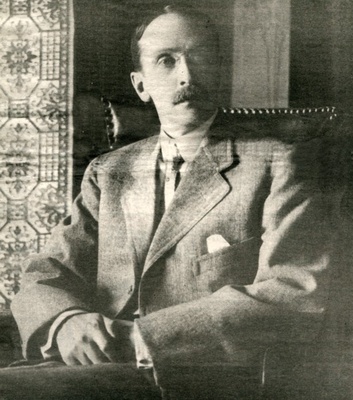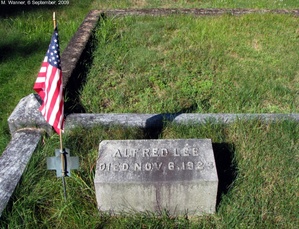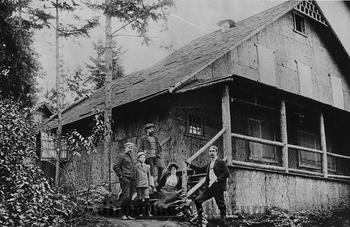 Alfred Lee Donaldson. Adirondack Daily Enterprise, October 3, 1998
Alfred Lee Donaldson. Adirondack Daily Enterprise, October 3, 1998  Alfred and Elizabeth Donaldson. Adirondack Daily Enterprise, March 21, 1987
Alfred and Elizabeth Donaldson. Adirondack Daily Enterprise, March 21, 1987  Alfred Lee Donaldson's tombstone in Pine Ridge Cemetery
Alfred Lee Donaldson's tombstone in Pine Ridge Cemetery  A brick at the Saranac Laboratory has been dedicated in the name of Alfred Donaldson by Diane and Rich Loeber. Born: 1866, New York City
A brick at the Saranac Laboratory has been dedicated in the name of Alfred Donaldson by Diane and Rich Loeber. Born: 1866, New York City
Died: November 6, 1923
Married: Elizabeth Hollingsworth
Children:
 c. 1890 photograph of Alfred L. Donaldson (right) at Camp Oteetiwi. Others in the photo include Dr. Arpad Gerster, John C.A. Gerster, Frederic Kammerer, and Mrs. A.G. Gerster.
c. 1890 photograph of Alfred L. Donaldson (right) at Camp Oteetiwi. Others in the photo include Dr. Arpad Gerster, John C.A. Gerster, Frederic Kammerer, and Mrs. A.G. Gerster.
Courtesy of the Adirondack Experience.Alfred Lee Donaldson was a banker who moved to Saranac Lake for his health in February of 1895, where he was treated by Dr. E. L. Trudeau. He lived in the Donaldson Cottage at 30 Church Street. With two other men in the same circumstances, William Minshull and John F. Neilson, he founded the Adirondack National Bank in 1897, the first national bank in the Adirondacks. When his health made continued work impossible, Donaldson wrote A History of the Adirondacks, a comprehensive two volume history of the park, published in 1921.
Alfred Donaldson also wrote the verse on the grave in Mansfield, Ohio, of John Baxter Black, the patient in whose memory the John Black wing of the Saranac Laboratory was given. The Donaldsons and the Blacks had been neighbors for a time across Church Street, and had become friends.
Donaldson Mountain, part of the Seward Range, is named for him.
Adirondack Daily Enterprise, March 21, 1987
Donaldson wrote history of Adirondacks
A popular current TV commercial poses the unanswered question "What if...." This same enigmatic phrase could easily be applied to almost any local situation with interesting results.
For example "What if" a young man from Milton, Vermont, had decided to build his hotel in his own back yard Green Mountains rather than on our side of Lake Champlain? If there had been no Paul Smith's there would have been no Dr. Trudeau in Saranac Lake. If there had been no Dr. Trudeau there would also have been no Alfred Lee Donaldson arriving here to take the cure, and no History of the Adirondacks.
Many noted writers were attracted to our village during the cure days, most notable was Robert Louis Stevenson. Stephen Chalmers came and Thomas Bailey Aldrich was here to be near his son who had contracted the disease. Of course Mark Twain summered on Lower Saranac but not to take the cure. John Dos Passes and Ernest Hemingway arrived to visit the same sick friend, as did the poet Archibald MacLeish.
Along came a very sick young man from New York City who was not yet an author but who was destined to put forth a literary work that would leave its indelible mark on the credit side of our community ledger for years to come.
While at work in his father's bank, Alfred L. Donaldson came down with tuberculosis and was immediately rushed off to Saranac Lake during February of 1895. Like so many others he placed himself under the care of Dr E.L. Trudeau whose reputation had spread far and wide. At last there was hope on the horizon for a possible cure for which all consumptives had prayed. Donaldson was a good patient; he accepted the doctor's advice with acquiescence and a cheerful attitude. He was fondly respected by all who came in contact with him since he sought no pity but rather exuded a spirit of bright optimism.
As his condition improved, Donaldson began to exhibit a keen interest in his surroundings and slowly became involved in community affairs. He was obviously a man of culture and wisdom. In his younger days he had traveled extensively in Europe where he studied both music and languages. In 1901 he published a collection of poems which he titled "Songs of My Violin" illustrated by William Distin. He also tried his hand at fiction with a detective story, "The Paddington Case."
In 1902 Donaldson married Elizabeth Hollingsworth, another health seeker at Saranac, who also shared his interest in music. The newlyweds acquired a home at 30 Church Street which is currently owned by Loren Miller. Having had experience in his father's bank Donaldson felt the village sorely needed a reliable bank to serve the entire area. He wrote to his father in New York asking for backing. His father was glad to help.
As a result The Adirondack National Bank was born, the first in the Adirondacks. Joining with Donaldson in this venture, by that common bond which seemed to link those taking the cure, were William Minshull and John Neilson. When this establishment gained solid ground Donaldson proceeded to organize a Savings and Loan Association, this time with two local businessmen, John Harding and W. J. Callanan.
Later he founded the Franklin Telephone and Telegraph Co. with Milo B. Miller and Wilbur Mussen. These expressions of confidence in the community led to his being elected village trustee for three years and then as village president for two more years.
Perhaps due to all of this business activity Donaldson fell victim to a relapse in 1910, and Dr. Trudeau advised him to take a complete rest. His friend, Stephen Chalmers, frequently came to call on him during this period of forced inactivity and one such visit led to the all important assignment which was to keep the patient occupied for ten years.
Donaldson says how it happened: "On a May morning, back in the year 1912, Stephen Chalmers, the author, then residing in Saranac Lake, called upon me and informally handed me my commission. He came from the local library, where he had gone to get some authentic information about a vaguely familiar event in Adirondack history. Failing to find any book that would answer his purpose, he had turned to the librarian for help. The librarian had said that there was no help, that the historical reference work he needed did not exist, although there was a constant demand for it. This led to some discussion of the situation and the unexpected conclusion that I was the logical person to produce the desired book, because I had both the leisure and the subsidiary patience. I displayed becoming hesitation, and had some real misgivings, but I finally yielded to the sympathetic lure of the adventure."
Having accepted the challenge, Donaldson set to the task of gathering information using every possible avenue of material collection at his disposal. He queried the local pioneers, guides, hotel keepers, lumbermen, and the wealthy owners of great camps. With those that could not come he maintained a voluminous correspondence. As the work progressed he assembled a private research library which soon contained all of the printed material pertaining to the region that he could lay hands on.
Donaldson was quite concerned with veracity and made earnest attempts to check and cross-check each story. As usual, however, with an undertaking of this magnitude, a few inaccuracies were bound to surface. These infrequent departures were by far overshadowed by the wealth of historical data rescued from oblivion. The author did a splendid job!
During the summer months Donaldson used a small camp on the shore of Lake Kiwassa for his workshop. In this relative solitude he could make uninterrupted progress while enjoying a closeness with nature that seemed to improve his health.
As the manuscript took shape it became apparent that one book alone could not contain all of the important details. From here on the chronicle became two volumes.
Throughout the writing term, a period that would cover ten years, Donaldson received loving support from his wife, both inspirational and technical. This special collaboration contributed greatly to the successful completion of the project as the author indicated in his dedication. During 1915 the public got its' first glimpse of what was coming by way of a series of articles in the local newspaper entitled "Chapters of Adirondack History." In this medium he asked for any additions or corrections prior to a final revision and a trip to the printer.
In 1921 A History of the Adirondacks was published in two volumes by the Century Co. of New York. This first edition completely sold out in short order which clearly indicated that the librarian, back in 1912, was correct in stating "There was a constant demand for it." When reaching the out-of-print status the books we all the more in demand as Adirondack history buffs searched frantically for a set of the valuable volumes.
Praise for the work come from many quarters. T. Morris Longstreth, a contemporary author, wrote "Mr. Donaldson has here done that rarest of things...a work not attempted before and that need not be attempted again. He has produced a history that is standard from the minute of publication by virtue of its having been composed so accurately, so affectionately, and so well."
In 1963 the second edition appeared in answer to the urgent demands of researchers but this issue also was a complete sell out. A third printing has been on the market since 1977. After some 66 years it has lost none of its appeal. It remains the recognized authority and number one source of local history.
Donaldson died in Saranac Lake on Nov. 6, 1923, but not before making a final valuable contribution to his adopted community. Just 11 days prior to his death, on Oct. 27th, he willed his private literary collection to the Saranac Lake Free Library where it formed the core of what has become one of the finest accumulations of Adironackana in existence. This is fitting indeed since it was here that the story began. Stephen Chalmer's question, which couldn't be answered in 1912, can now be solved quite easily from the prestigious rows of books encased behind the glass paneled shelves of the Donaldson-White Adirondack Room.
From a piece on the Donaldson Block by Phillip Gallos
Alfred L. Donaldson was born in New York City in 1866. As the son of a wealthy, banking family it was hoped he would go to Yale; but he seemed to be more interested in making music than making money. Instead of going to Yale, he went to Europe to study violin. While abroad he met, among others, a man named Richard Wagner and a young woman named Marie Saussenthaler. (see the Haase Block)
The former name, of course, needs no further elaboration. As for the latter person, she was the talented daughter of a St. Louis family whose means were derived from the brewing of beer. She had graduated from the Beethoven School in her home city and had gone to study in Paris and Vienna on her way to becoming a concert violinist.
The two violin students had much in common and became friends; but Donaldson returned to New York and Marie to St. Louis, he to try to live up to parental expectations in the banking business and she with the boy next door who had followed her to the Continent to become her husband. Their paths, though, would join again.
Donaldson had never been robustly healthy. Back in Manhattan, carrying the burden of family pressure and engaging in work that gave him little, if any, spiritual satisfaction, he suffered a general physical breakdown. Following a scenario so often and tragically repeated in those times, Donaldson was found to have contracted tuberculosis.
He arrived in Saranac Lake in February of 1895. He would spend the rest of his life here — nearly 30 years.
A mere two years after coming under the care of Dr. E. L. Trudeau, Donaldson was back in the banking business — this time by his own choice. At the time, Saranac Lake had no nationally accredited commercial bank; so Donaldson, with two other banker-health seekers, founded the village's first, the Adirondack National Bank, in 1897.
In 1901, Donaldson published a book titled Songs of My Violin (G.P. Putnam's Sons, New York), a brief work the chief feature of which is an octet of poems — a quartet of pairs, one for the "spirit" and one for the "song" of each string of the violin, to which the author had ascribed a color according to the character of its tonal quality. Each of these poems was preceded by a bar or two from one of Wagner's operas. The idea was a fine one, but, unfortunately, his poetic ability was not a match for it, and the book did not sell.
The following year Donaldson married Elizabeth Hollingsworth. They had met as fellow convalescents who shared passionate interest in music, and the strength of their bond in a large measure gave strength to their health, though he remained the more delicate of the two.
In 1910, having long been vitally and busily involved in the growth of the village, Donaldson suffered a relapse and was forced to "retire". It was to be a very odd sort of retirement. Not long after its inception, a friend, author Stephen Chalmers, came to Donaldson with a problem and a suggestion.
Chalmers had needed some information about the area's past, had gone to the local library, and had been told that, though sorely needed, there was no source book on Adirondack history. That was Chalmers' problem. His suggestion was that Donaldson should write one.
Though he did not make an effusive show of it, Donaldson liked the idea enough to spend the next decade gathering material for and writing his two-volume History of the Adirondacks (Century Co., New York). Published in 1921, it is, to this day, the only thorough, general history for a region larger than the State of New Jersey and with a rich heritage indeed. Alfred Donaldson died in November 1923.
Probably before the end of 1901, Donaldson erected the building called the "Donaldson Block" at 56 Main Street. As far as is known, the first occupants of its two storefronts were the Western Union Telegraph and Cable Co. and George Baldwin, photographer.
See also:
Sources
- Donaldson, Alfred L. A History of the Adirondacks, New York: The Century Co., 1921 (reprinted by Purple Mountain Press, Fleischmanns, NY, 1992)



